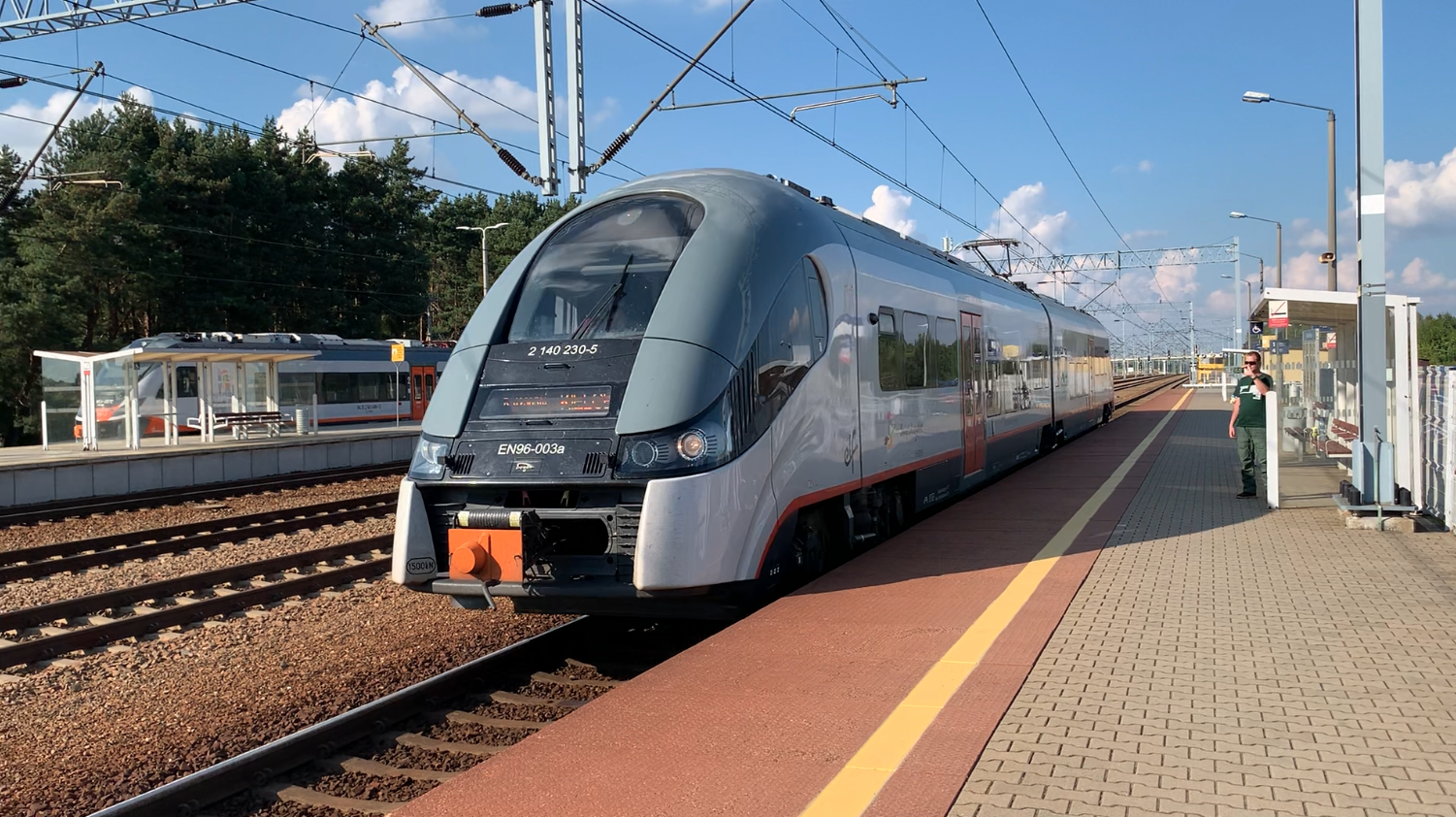Włoszczowa 2025-10-01
EMU PESA Elf type EN96-003.
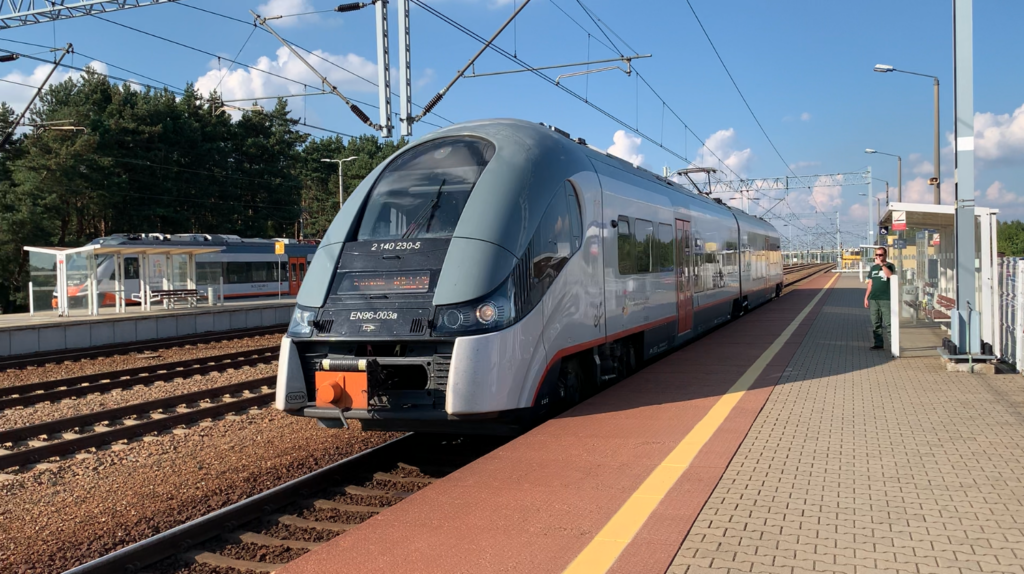
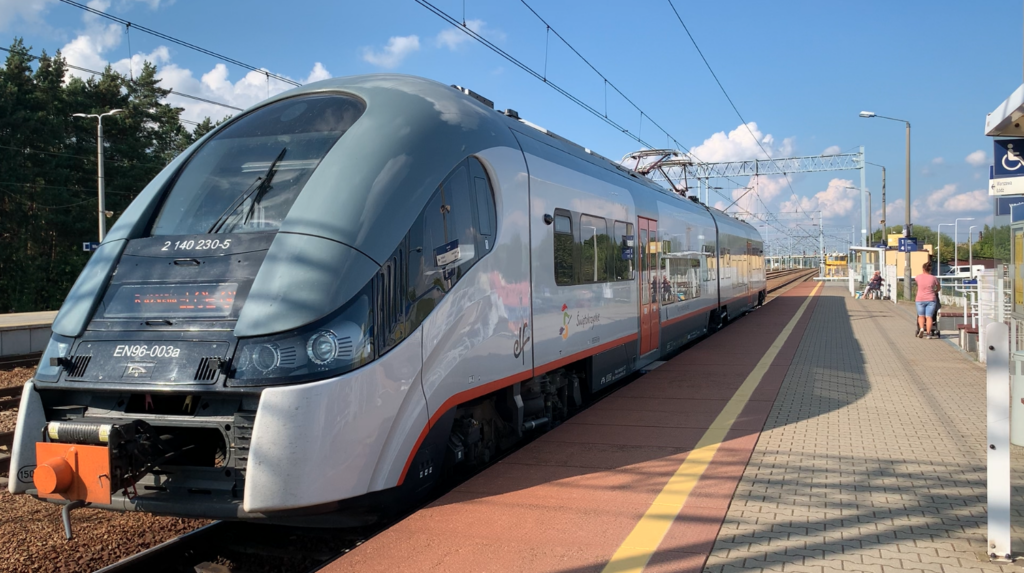
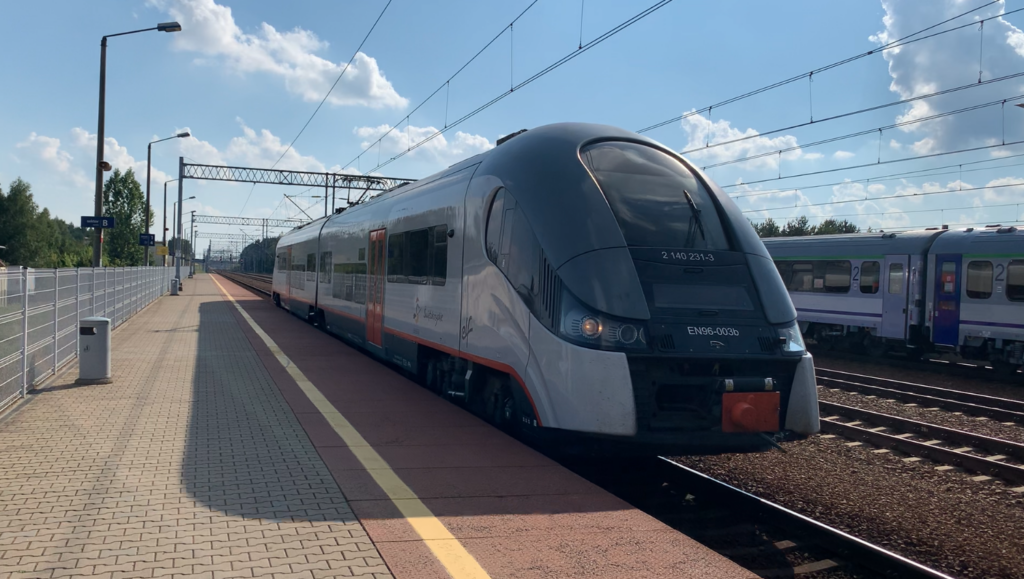
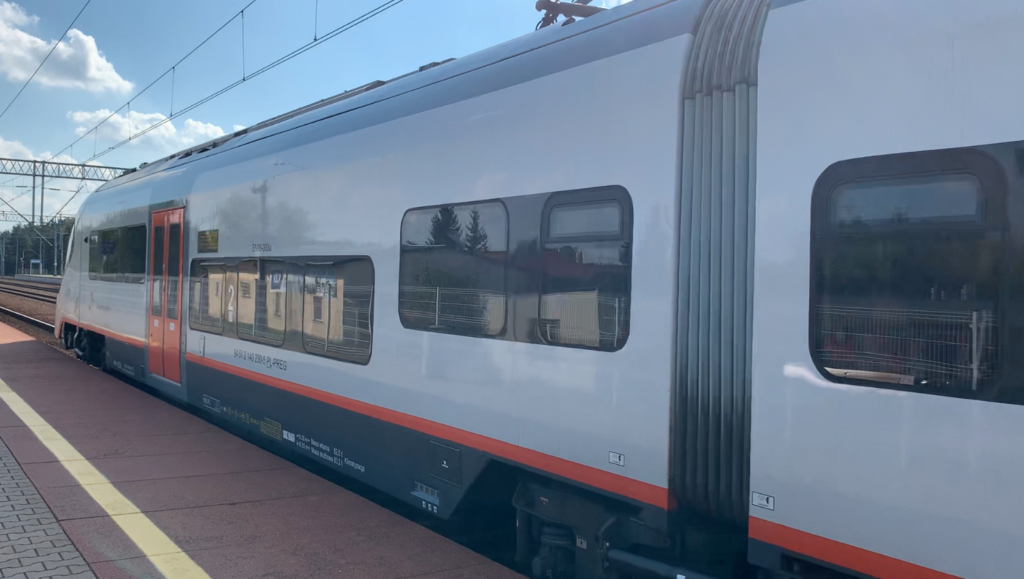
The PESA Elf type EN96-003 EMU is a train built by PESA Bydgoszcz. The train is type EN96 and 34WE. Currently, the train is owned by PolRegio in the Świętokrzyskie branch. The branch is headquartered in Skarżysko Kamienna. The EN96 is a two-car electric multiple unit, low-floor, “Electric Low Floor,” which means easy boarding thanks to a lower entrance floor, making it easier for people with limited mobility, strollers, and bicycles. That’s why the trains were named “Elf.” The manufacturer anticipated the possibility of expanding the vehicle with more units in other versions, but the EN96 is the basic two-unit version.
The drive system utilizes asynchronous electric motors powered by 3 kV DC, similar to other Elf trains of this type. The structure is based on a steel frame. The steel used is corrosion-resistant. The car skin is also made of sheet steel. The front modules of the trains are made of plastic. Sliding doors are fitted on both sides of the cars. Additionally, a retractable step under the doors extends for very low platforms. The number of doors is determined by the customer.
EN96-003 train specifications: Total length: 42.65 m, width: 2.88 m, height: 4.28 m. Floor height at the railhead door is 0.76-0.80 m. The train has 107 seats. The train is certified for a speed of 160 km/h. The train uses four asynchronous motors with a power output of 4 x 400 kW = 1,600 kW. The axle arrangement is Bo’2’Bo’, meaning two driving (outer) bogies and a central Jacobs-type trailing bogie. Kerb weight: 83,200 kg.
The world premiere of the PESA Elf train took place on September 21, 2010, at the InnoTrans trade fair in Berlin. The company then presented the EN76-001 train, designed for the Silesian Voivodeship. The Elf train was unveiled at the Polish Trako Trade Fair in Gdańsk in October 2011. The Elf train family was designed as a multi-purpose train platform. Furthermore, in 2013, PESA presented the Actus Plus EMU. This train is a more affordable version of the Elf trains, which also meets all safety requirements. Furthermore, PESA presented EMUs adapted for intercity traffic. However, at that time, PKP Intercity was not interested in this proposal.
The need for rail vehicles to meet technical interoperability specifications meant that, starting in 2016, PESA discontinued the sale of the Elf EMU in favor of the Elf II EMU, which differed from its predecessor in compliance with these requirements, among other things. The first customer for the Elf II EMU was Koleje Śląskie, which, together with the Silesian Voivodeship, ordered a dozen or so units in October 2016.
In connection with PESA’s export plans for the Elf EMU family, the company developed the Elf.eu platform, adapted to the requirements of customers outside Poland. It is based on Elf II vehicles. However, the train is distinguished by, among other things, its multi-system power supply and its adaptation to voltages of 3 kV DC and 25 kV AC. Trains from the Elf.eu platform can be configured with 2 to 5 carriages. The first operator to order Elf EU EMUs was the Czech Republic’s RegioJet, which ordered dual-mode, two-car units. They differ from ELF trains for Polish operators in that they have longer carriages supported by independent bogies. On August 14, 2022, the first unit completed its first run on the Czech infrastructure.
Elf EMU Design
Elf EMUs are standard-gauge, low-floor trains that are wheelchair-accessible. The passenger section has an open layout, with no doors between carriages. The number of entrance doors, the layout and number of seats, and the interior color scheme are determined by the customer. Trains can have 2, 3, 4, 5, or 6 carriages. Long-distance trains can have up to 10 carriages and a maximum speed of 200 km/h. The trains can be equipped with bogies with wheels adapted to a rail gauge of 1520 mm, i.e. the Russian gauge, but no EMU of this type has been ordered.
In most EMUs, the first and last bogies are the driving bogies. In 6-, 8-, and 10-car trains, there are one or two additional driving bogies in the middle of the train. The bogies between the cars are Jacobs-style trailer bogies. Separating the train is only possible in workshops.
Elf bogies are equipped with two levels of suspension. The first is steel springs, and the second is pneumatic springs (Conti Tech air springs) with an emergency spring. There are two air springs on the standard bogies and four on the Jacobs bogies. The bogies are equipped with hydraulic shock absorbers. Elf trains can be coupled into multiple units, including 2-, 3-, 4-, 5-, and 6-car EMUs. A maximum of three trains can be coupled.
The box frame is made of corrosion-resistant steel. The skin is made of 1.5 mm thick stainless steel sheet. The trains’ front ends are made of plastic and mounted on a safety cage. All doors are located in a low-floor area, with retractable steps underneath. A closed-loop toilet is located in the passenger compartment. There are spaces for wheelchair passengers, bicycle storage, and storage for larger luggage. The driver’s cabs have two seats: one for the driver and one for an assistant. Two-person crew are required when the trains travel at speeds over 130 km/h. This is a requirement of railway regulations. The first five Elf type 22WEc EMUs are designed for speeds of 120 km/h, while all subsequent ones are designed for speeds of 160 km/h.
Version 34WE, or EN96, is a two-car regional version of the Elf with one pair of doors per car. Compared to previous versions, passenger space has been increased by relocating some of the equipment to the roof of the unit. The lighting was changed to LED and 230V power outlets were installed. Four asynchronous motors with a power output of 4 x 400 kW were used, but their power was electronically limited to 4 x 360 kW. This allows for the future addition of an additional carriage and the full power of the motors. At the request of the client, a passenger counting system and a travel time analyzer were installed. A new passenger information system was installed.
Ingeteam IGBT 0.8 MW traction inverter. Ingeteam 200 kW static converter. Traktionssysteme Austria (TSA) TMF 50-29-4 asynchronous motors (400 kW). Axle transmission by Gmeinder Getriebe- und Maschinenfabrik 275 SO/549. Stemmann DSA current collectors. Knorr-Bremse braking system. Drive bogie by PESA with a 2.70 m gauge. Trailer bogie by PESA.
PolRegio Świętokrzyskie Branch.
On August 17, 2010, a contract was signed with the Świętokrzyskie Voivodeship government for the delivery of four two-unit Elf 34WE, EN96 electric multiple unit (EZT) trains. On October 5, 2011, the first unit was officially handed over at Kielce station, during which invited guests were transported to nearby Sitkówka. In the following days, the train was presented at other stations: Skarżysko Kamienna, Ostrów Wielkopolski, and others. All four units were manufactured in 2011: EN96-001, EN96-002, EN96-003, and EN96-004.
EMU type 34WE, EN96-003:
Carriage numbers EVN: 94 51 2 140 230-5 (PL-PREG a), EVN: 94 51 2 140 231-3 (PL-PREG b). Serial number 34WE-003/2011. The train was accepted by the Marshal’s Office of the Świętokrzyskie Voivodeship, for Regional Transport, on November 30, 2011. In November 2016, a P4 repair was performed. In December 2021, another P4 repair was performed.
Written by Karol Placha Hetman
